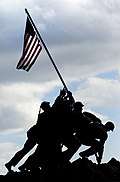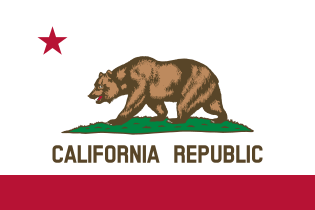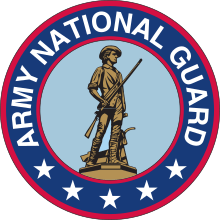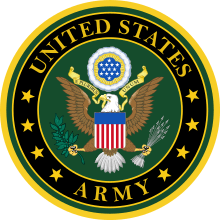California during World War II
California during World War II was a major contributor to the World War II effort. California's long Pacific Ocean coastline provided the support needed for the Pacific War. California also supported the war in Europe. After the Japanese attack on Pearl Harbor, Hawaii, on December 7, 1941 most of California was shifted to the war effort. California became a major ship builder and aircraft manufacturer. Existing military installations were enlarged and many new ones were built. California trained many of the troops before their oversea deployment. Over 800,000 Californians served in the United States Armed Forces. California agriculture, ranches and farms were used to feed the troops around the world. California's long coastline also put the state in fear, as an attack on California seemed likely. California was used for the temporary and permanent internment camps for Japanese Americans. The population of California grew significantly, largely due to servicemen who were stationed at the new military bases/training facilities and mass influx of workers from around the U.S. in the growing defense industries. With all the new economy activity, California was lifted out of the great depression. Over 500,000 peopled moved to California from other states to work in the growing economy. California expanded its oil and mineral production to keep up with the war demand.[3][4][5][6][7]
| California during World War II | |
|---|---|
| Location | California, United States |
| Date | 1941–1945 |
| Casualties | 17,022[1][2] |

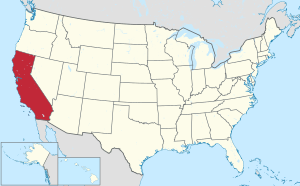
History
Economics and population growth
Mining, natural gas, and oil production were active industries in California before World War II, and these rapidly expanded to support the war effort. Like World War I, the mines and mining towns came to life again, due to an increase in demand for gold, copper and silver. In 1941 California oil production was 230,263,000 barrels; by the end of the war in 1945 the output was 326,555,000 barrels.[8] After the attack on Pearl Harbor and America entered the war, there was a quick build of new military bases, airfields, training camps and other military installations. New military construction projects and the emerging war industries in California brought in tens of thousands of workers from across America. After the war, many stayed in California, with some others returning back to their home states. Towns and cities next to military and industrial facilities grew and had an increase in economy. California's population in 1940 was 6,907,387 and by 1950 it had grown to 10,586,223, a 53.3% increase.[9] Many military personnel who were trained in California returned after the war to tour the state, so California's tourist industries began to grow. Federal Aid Highway Acts built the Interstate Highway System so motorists were able to travel the state. Disneyland opened in 1955, Knott's Berry Farm which had opened in 1920 expanded, SeaWorld opened in 1964, and Universal Studios opened up its studio tour in 1964 which started the Universal Studios Hollywood theme park; these became some of the world's most visited tourist attractions.[10]
Food production
California's mild climate made it ideal for year-round food production.[11] Even with the increase in food production there was mandatory food rationing. Civilians were encouraged to plant Victory gardens to help with the food shortage. The slogan "grow your own, can your own", was started at start of the war and referred to families growing and canning their own food in victory gardens.[12][13] Tires and gasoline were also rationed.[14][15] Rationing of wool fabric was also required during the war. This is one of the causes of the June 1943 Zoot Suit Riots in Los Angeles. [16]
Enemy aliens
- After the attack on Pearl Harbor it was feared that some Japanese Americans might be loyal to the Empire of Japan and the Emperor of Japan. On February 19, 1942 President Franklin D. Roosevelt signed Executive Order 9066, which authorized the Secretary of War to set some military zones for the internment of Japanese Americans. California had some of the US prisoner of war camps and Japanese Americans internment camps. War Relocation Authority built both temporary and permanent relocation camps. As aliens they had to register in accordance with the law and were required to turn in all weapons and short-wave radios. Japanese Americans first were sent to one of California's 11 temporary relocation camps, like the two in southern California: Pomona assembly center and the Santa Anita assembly center. From these centers many were sent to other states and some were sent to California's Manzanar War Relocation Center, California or the Tule Lake War Relocation Center.[17][18][19][20][21][22]
- Camp Haan was built at near March Air Reserve Base, the camp housed 1,200 Italian prisoners of war (POW). German POWs were also housed at the camp. The camp was named after Major General William G. Haan. In all 21 POW camps were built in California. A number of Italian POWs, pledged to help the United States. About 70% to 90 % of the Italian POWs volunteered for Italian Service Units (ISU). Due to labor shortage the Italian Service Units helped on Army depots, arsenals, farms and hospitals, there they volunteered to work and received better housing, than the standard POW camps.[23] [24][25][26][27]
Attacks on California
- On February 23, 1942 the Japanese bombed the Ellwood Oil Field. The Ellwood Oil Field and oil refinery are located in Goleta, California in the Santa Barbara Channel. A Japanese submarine fired 16 shells at the Oil Field from its deck gun before running. This attack along with the Niihau Incident started the fear of the invasion of California. This also started the idea of the internment of Japanese Americans.[28] There were no casualties in the attack. The total cost of the damage was approximately $500–1,000.[29] News of the attack triggered an invasion scare along the West Coast of the United States.[30][31]
- Fu-Go balloon bombs were the other attack on California and 14 other states. Japanese launched fire bomb balloons across the Pacific Ocean. These high-altitude balloons carried bombs and incendiary explosives. In California 25 fire bomb balloons were found, none caused injuries in California. The balloon bombs were launched in Japan from November 3, 1944 to April 1945. On February 23, 1945 a P-38 Lightning plane shot down a balloon near Santa Rosa, California.[32][33][34]
- Ships off the coast were attacked: SS Agwiworld (escaped), SS Emidio (sank), SS Samoa (escaped) [35], SS Larry Doheny (sank), SS Dorothy Phillips (damaged), SS H.M. Storey (escaped, sank later), SS Camden (sank), SS Absaroka (damaged), SS Montebello (sank), SS Barbara Olson (escaped), SS Connecticut (damaged), SS Fort Camosun (Sank), and SS Idaho [tanker] (minor damage).[36][37][38][39] [40][41][42][43][44][45] [46]
- Due to fear California coastal cites turned off lights or blacked out windows at night. Some sandbagged their homes and businesses. Some radio stations went off the air and civil ships were ordered to stay in port. Commercial air travel was grounded.[47][48][49][50] A military defense system was installed up and down the coast, that included blimps, patrol ships, artillery batteries, and aircraft. [51][52]
Ammunition
California was a major ammunition manufacturer for the war. Off the California coast, ships worked around the clock to harvest kelp of the vast California kelp forest. The kelp's nitrate, actin and potash was used in the making of gunpowder.[53] The largest World War II accident in California was the Port Chicago disaster. The Liberty ship SS E. A. Bryan exploded on July 17, 1944 while being load with ammunition. About 4,600 tons (4,173 tonnes) of explosives had been loaded in the ship's holds at the time. The explosion killed 320 sailors and civilians and injured 390 others. SS Quinault Victory, situated next to SS E. A. Bryan, was destroyed and a United States Coast Guard fireboat sank. The trains at the port, the port's buildings and much of the surrounding town were severely damaged. Riverbank Army Ammunition Plant in Stanislaus County and Benicia Arsenal were two of the largest ammunition makers.[54][55][56][57]
Hollywood
Hollywood's motion-picture industry continued to make movies during the war. In addition to entertainment films, Hollywood made training films and films to raise morale.[58][59][60]
Bob Hope volunteered with the United Service Organizations (USO) and entertained troops during World War II and for decades later (1941 to 1991). Hope brought many Hollywood stars with him on his USO tours.[61] Overlapping with this was his movie career, spanning 1934 to 1972, and his USO tours, which he conducted from 1941 to 1991.[62][63]
Desi Arnaz was stationed at Birmingham General Army Hospital in Van Nuys, California during the war to entertain the troops there. Arnaz had a bad knee and so was transferred to the US Army Medical Corps. Arnaz also coordinated with the stars that visited the hospital. Arnaz was discharged on November 16, 1945.[64]
War Bond sales
To help pay for the war the US sold war bonds. With its booming economy during World War II, Californians was one of the top of US War Bonds sold. Much of the advertising for war bonds was donated. The spirit of sacrifice was never stronger for the defense of democracy and a way of honoring the sacrifices of American troops. Named after the 1942 Hollywood Victory Caravan, Paramount-produced film promoted bond sales in a 1945, post War. The short film included Bing Crosby, Bob Hope, Alan Ladd, William Demarest, Franlin Pangborn, Barbara Stanwyck, Humphrey Bogart, and others. Other heroes like boxing Joe Louis and Joe DiMaggio sold war bonds. Albert Einstein donated the original copies of his manuscript on the theory of relativity for auction to raise money for war bonds. [65][66]
California National Guard
California National Guard was mobilized and called to active duty in August 1940. The US Army recruited the first group to deploy to the war in Europe. The others troops called up were sent to the Pacific war. Between 1940 and 1941 about 12,000 California National Guard troops were called up to service in federal duty. Some troops were used for the defense of California and Hawaii.[67]
Manufacturing
Ship building
California became a major builder of ships for the war. Under the Emergency Shipbuilding program, cargo ships like Liberty ships and Victory ships were built in days, not the normal months. Ships that could be repaired overseas greatly deduced repair time, so California shipyards also built floating dry docks like the Large Auxiliary Floating Dry Docks and Medium Auxiliary Floating Dry Docks. At the end of the war there was a surplus of ships and most shipyards were closed. Surplus ships were either sold or put into the Navy Reserve Fleet, like the Suisun Bay Reserve Fleet. California ship yards:[68][69][70][71][72][73]
- California Shipbuilding in Wilmington
- Consolidated Steel Corporation in Wilmington
- Richmond Shipyards of Permanente/Kaiser Yard #1, #2, #3 and #4 in Richmond
- Todd California Shipbuilding Corporation in Richmond
- Marinship, in Sausalito
- Consolidated Steel Corporation in Wilmington
- Bethlehem Shipbuilding Corporation in San Pedro
- Moore Dry Dock Company in Oakland
- Federal Shipbuilding and Drydock Company in San Francisco
- Western Steel in San Francisco
- Mare Island Naval Shipyard in Oakland
- Hunters Point Dry Docks in Bayview–Hunters Point, San Francisco
- Pollock-Stockton Shipbuilding Company in Stockton
- Bath Iron Works Corporation
- Hanlon Dry Dock & Shipbuilding in Oakland
- Pacific Coast Shipbuilding in Bay Point
- Union Construction Company in Oakland
- Hodgson-Greene-Haldeman wood ships, Long Beach
- Standard Shipbuilding Co., wood ships in San Pedro
- Eureka Shipbuilding Co., wood ships, Eureka
- Concrete Ship Constructors, Inc. in National City
- Barrett & Hilp, Concrete Ships in South San Francisco
- Colberg Boat Works in Stockton
- Stephens Brothers in Stockton
- Guntert and Zimmerman in Stockton
- Hickinbotham Brothers in Stockton
- Kyle and Company in Stockton
- Clyde Wood in Stockton
- Moore Company in Stockton
- Nicholson's in Stockton
- Stockton Steel Fabrications Company in Stockton
- Anderson & Cristofani in San Francisco
- Barrett & Hilp in San Francisco
- Basalt Rock Company in Napa
- Benicia Shipbuilding in Benicia
- Campbell Industries in San Diego
- Cryer & Sons in Oakland
- Fellows & Stewart in Wilmington
- Fulton Shipyard in Antioch
- National Steel and Shipbuilding Company NASSCO in San Diego
- General Engineering in Alameda
- Hammond Lumber in Humboldt Bay
- Harbor Boatbuilding at Terminal Island
- Kneass, G. W. in San Francisco
- Larson Boat Shop, Al in San Pedro
- Long Beach Shipbuilding in Long Beach
- Lynch Shipbuilding in San Diego
- Pacific Bridge Company in San Francisco
- Peyton Company in Newport Beach
- Rolph Shipbuilding in Fairhaven
- San Diego Marine
- San Francisco Naval Shipyard
- South Coast Shipbuilding in Newport Beach
- Southwestern Shipbuilding in San Pedro
- Stone & Sons, William F. in Oakland
- Union Brass & Iron Works in San Francisco
- Victory Shipbuilding in Newport Beach
- Wilmington Boat Works in Wilmington
- Aetna Iron & Steel in San Diego
- American Pipe in Los Angeles
- California Steel in Richmond
- Garbutt-Walsh in San Pedro
- Hunt Marine Service in Richmond
- Independent Iron Works in Oakland
- Madden, Lewis in Sausalito
- Sacramento Shipbuilders in Sacramento
- Sausalito Shipbuilding in Sausalito
- Soule Steel in San Francisco
- Standard Steel in Los Angeles
- Stanwood Shipyard in Stanwood
- United Concrete Pipe in Los Angeles
- Wilson Company in Wilmington
Aircraft manufacturers
Built in California were B-17 Flying Fortress, Lockheed P-38 Lightning, Douglas C-47 Skytrain, Douglas SBD Dauntless, Douglas A-26 Invader, Lockheed Ventura, Lockheed Model 18 Lodestar, Lockheed P-2 Neptune, Lockheed Constellation, Douglas P-70 Nighthawk, Douglas DC-5, Douglas C-54 Skymaster, Douglas BTD Destroyer, Douglas A-33, Douglas TBD Devastator, Northrop A-17, Northrop BT, Northrop N-3PB, Northrop P-61 Black Widow, McDonnell FH Phantom, Consolidated B-24 Liberator, Consolidated PB2Y Coronado, Consolidated TBY Sea Wolf, Consolidated B-32 Dominator, Consolidated P-30,North American B-25 Mitchell, North American P-51 Mustang, Vultee A-31 Vengeance, Vultee BT-13 Valiant, Vultee P-66 Vanguard, Vultee V-11, Interstate Cadet, Interstate TDR, Timm N2T Tutor and the Waco CG-4. By the end of the war California had 70% of the aerospace manufacturing in the United States.
[74]
Aircraft manufacturers of World War II in California:
- Douglas Aircraft Company
- Lockheed Corporation
- Vega Aircraft Corporation
- Northrop Corporation
- Hughes Aircraft Company
- McDonnell Aircraft Corporation
- Consolidated Aircraft
- North American Aviation
- Glenn L. Martin Company
- Harlow Aircraft Company
- Convair
- Vultee Aircraft
- Interstate Aircraft
- O.W. Timm Aircraft Company
- Western Aviation Company
- Hiller Aircraft
- Bartlett Aircraft
- Menasco Motors Company
- Cal Aero Academy
Vehicles manufacturers
- General Motors South Gate Assembly built Stuart M-5 Light Tanks at 500 per month.[75][76][77]
- Ford Motor Company Assembly Plant in Richmond built the jeep. The Ford plant also did completion work on tanks, armored personnel carriers, armored cars and other military vehicles.[78]
- Willys-Overland built jeeps in Maywood, California.[79]
- Chrysler California stop vehicles manufacturing during the war and built 40,000 aircraft engines and B-17 and PV-2 Harpoon cabin.[80]
- Studebaker Pacific Corporation stop vehicles manufacturing during the war and built engines for the B-17s and PV-2 Harpoons.[81]
Military installations
Like other states in the desert Southwest, many of the new military installations built were United States Army airbases. California's weather, wide open spaces, railroad connections, and access to ocean made it an ideal location for training pilots, also armored vehicles operators.[82][83][84]
Desert Training Center
The largest United States Army training installation in the history of the United States was the Desert Training Center. To prepare troops for the battles in the North African campaign, the army had General Patton build many desert training camps in Southern California and a few in Arizona. The camps were built in the Mojave Desert and Sonoran Desert. The open space let the Army and Army Air Corps use live fire to train troops, test and develop equipment. Tactical doctrines, techniques, and training methods for combat were developed from this training. From 1 April 1942 to 1 July 1944, the complete training area covered 18,000 square miles. The camp reached from Pomona, California east to almost to Phoenix, Arizona and from Yuma, Arizona northward into the southern tip of Nevada.[85]
California Army Divisional Camps
- Camp Clipper and Camp Essex
- Camp Coxcomb
- Camp Granite[86]
- Camp Ibis
- Camp Iron Mountain
- Camp Pilot Knob
- Camp Young
California Army Depots
- Camp Freda Quartermaster Depot
- Camp Desert Center
- Camp Goffs – Depot and Infantry training.
- Pomona Ordnance Depot
California Army Airfields
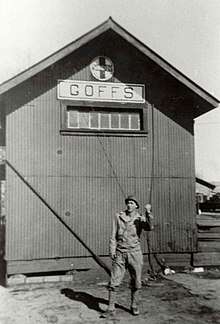
- Major airfields
- Blythe Army Air Base
- Desert Center Army Airfield
- Thermal Army Airfield
- Rice Army Airfield
- Shavers Summit Army Airfield (now Chiriaco Summit Airport)
- Minor airfields
- Camp Coxcomb Army Field (abandoned)
- Camp Essex Army Field (abandoned)
- Camp Goffs Army Field (abandoned)
- Camp Ibis Army Field (abandoned)
- Camp Iron Mountain Army Field
Desert Training Center California Hospitals
- Banning General Hospital (Banning, CA)
- Camp Freda Hospital
- Camp Desert Center Hospital
- Camp Goffs Hospital
- Torney General Hospital
- Needles Station Hospital
California Naval Bases
United States Navy World War II bases in California:[87]
- Mare Island, Vallejo, California
- Naval Base San Diego, San Diego
- Naval Air Weapons Station China Lake, China Lake
- Naval Base Ventura County, Point Mugu
- Naval Postgraduate School, Monterey
- Naval Weapons Station Seal Beach, Seal Beach
- Naval Air Station Point Mugu, Point Mugu
- Naval Construction Battalion Center Port Hueneme
- Naval Hospital Pendleton, San Diego
- Naval Medical Center San Diego
- Naval Air Station North Island, San Diego
- Naval Base Point Loma
- Naval Air Base San Pedro
- Long Beach Naval Shipyard
- Terminal Island San Pedro
- Naval and Marine Corps Reserve Center in Los Angeles
- Naval Air Station, Santa Ana
- Moffett Federal Airfield
- Naval Training Center San Diego
- Naval Station Treasure Island
- Naval Amphibious Base Coronado
- McCormack General Hospital
- Watsonville Airport
- Naval Air Auxiliary Station Watsonville
Air bases and airfield
United States Army Air Corps World War II bases in California:[88][89]
- Beale Air Force Base (Camp Beale), Marysville
- Muroc Army Airfield now Edwards Air Force Base
- March Field, Riverside
- McClellan Air Force Base, Sacramento
- Fairfield-Suisun Air Force Base now Travis Air Force Base
- Camp Cooke now Vandenberg Air Force Base, Lompoc
- Los Alamitos Joint Forces Training Base
- Lemoore Army Air Field
- Long Beach Army Air Field
- Lomita Flight Strip
- Ontario Army Air Field
- San Bernardino Army Air Field
- Van Nuys Army Air Field
- Chino Airport
- Clover Field
- Merced Army Air Field
- Grand Central Air Terminal
- Lockheed Air Terminal
- Mines Field
- Victorville Army Air Field
- Hamilton Army Airfield
- Mather Air Force Base
- Norton Air Force Base
- Salton Sea Naval Auxiliary Air Station
- McClellan Field
- Hammer Field
- Gardner Army Airfield
- Minter Field
- Santa Maria Field
- Chico Field
- Santa Ana Army Air Base
- Palm Springs Air Base
- Fresno Air Base
- Bishop Army Airfield
- Blythe Army Airfield
- Palmdale Army Airfield
- Gary Army Airfield
- Chico Army Air Field
- Reno Army Air Base
- Barstow-Daggett Airport
- Montague Air Force Auxiliary Field
- Napa Army Airfield
- Willows Municipal Airport
- Redding Army Airfield
- Siskiyou County Army Airfield
- Salinas Army Air Base
- Delano Army Airfield
- Capitola Airport
- Meadows Field
- Visalia Army Airfield
- Hayward Army Airfield
- Orland Auxiliary Field
- Kirkwood Auxiliary Field
- Vina Auxiliary Field
- Campbell Auxiliary Field
- Oroville Auxiliary Field
- Sacramento Municipal Airport
- Oroville Army Airfield
- Siskiyou County Army Airfield
- Redding Army Airfield
- Boston Field
- Huron Field
- Indian Field
- Murray Field
- West Field
- Helm Field
- Corcoran Municipal Airport
- Porterville Army Airfield
- Coalinga Municipal Airport (Old)
- Buffalo Springs Airport
- Needles Army Airfield
- Shavers Summit Army Airfield
- Rice Army Airfield
- Half Moon Bay Flight Strip
- Estrella Army Airfield
- Santa Rosa Army Airfield
- Thermal Army Airfield
- Corcoran Airport
- Douthitt Strip
- Dos Palos Airport
- Trauger Auxiliary Field
- Hunter Auxiliary Field
- Caliente Flight Strip
- Franklin Auxiliary Airfield
- Hawthorne Municipal Airport
- Hayward Executive Airport
- Hemet-Ryan Airport
- Independence Airport
- Inyo County Airport
- Lancaster Airport
- Adamson Landing Field
- Mefford Field Airport
- Palo Alto Airport
- Gibbs Auxiliary Field
- New Jerusalem Auxiliary Airfield
- Porterville Army Airfield
- Rankin Field
- Redding Army Air Field
- Lindbergh Field
- San Francisco Airport
- Sequoia Field
- Stockton Army Airfield
- Sherman Army Airfield
- Kingsbury Auxiliary Airfield
- Tracy Auxiliary Airfield
- Modesto Auxiliary Airfield
- Twenty Nine Palms Army Airfield
- Visalia Army Air Field
- War Eagle Field
- Willows-Glenn Airport
- Winters-Davis Flight Strip
- Marysville Army Airfield
- Parker Auxiliary Airfield
- Kern Field Auxiliary Airfield
- Allen Auxiliary Airfield
- Conners Auxiliary Airfield
- Taft Auxiliary Airfield
- Cuyama Auxiliary Airfield
- Wasco Auxiliary Airfield
- Pond Auxiliary Field
- Famoso Auxiliary Airfield
- Dunlap Auxiliary Airfield
- Semi-tropic Auxiliary Airfield
- Poso Auxiliary Airfield
- Lost Hills Auxiliary Airfield,
- Hawes Auxiliary Airfield
- Helendale Auxiliary Airfield
- Howard Auxiliary Field
- Athlone Auxiliary Field
- Potter Auxiliary Field
- Liberty Auxiliary Field
- Victory Field Auxiliary Field
Coast Guard
United States Coast Guard World War II bases in California:
Army Bases
- Fort Irwin
- Fort Ord
- Fort Hunter Liggett
- Parks Reserve Forces Training Area
- Presidio of Monterey
- Camp Roberts (ARNG)
- Military Ocean Terminal Concord
- Camp Anza
- Camp Callan
- Camp Kearny
- Camp Lockett
- Fort Emory
- Oakland Army Base
- Fort Funston
- Fort MacArthur
- Fort Mason
- Fort McDowell
- Fort Miley Military Reservation
- Camp McQuaide
- Camp Stoneman
- Fort Point
- Fort Baker
- Oakland Army Base
- Presidio of San Francisco
- Sacramento Army Depot
- San Carlos War Dog Training Center
- Camp Seeley El Centro
- Santa Anita Ordnance Training Center
- Camp Roberts Army Base Monterey
- Camp San Luis Obispo, San Luis Obispo
- San Joaquin Depot[90]
- Sharpe Facility[91]
- Rough and Ready Island Naval Supply Depot in Stockton[92]
- Tracy Facility[93][94]
- Stockton Ordnance Depot
- Sierra Army Depot in Herlong
- Birmingham General Hospital
- Mitchell Convalescent Hospital
- Camp Ross
- Benicia Arsenal
- Camp Ono for POWs
- Fort Barry
- Fort Cronkhite
- DeWitt General Hospital
- Camp Kohler
- Camp Shoemaker
- Camp Flint
- Camp Tulelake
- Camp Tracy
Marine Corps
- Camp Pendleton San Diego
- Marine Corps Air Station Miramar San Diego
- Marine Corps Logistics Base Barstow Barstow, Yermo Quartermaster Sub-Depot
- Marine Corps Recruit Depot San Diego San Diego
- Marine Corps Air Station Camp Pendleton
- El Toro Marine Corps Air Station
- Tustin Marine Corps Air Station
Gallery
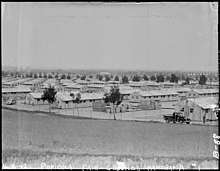 Pomona assembly center, temporary Detention Camp for Japanese Americans
Pomona assembly center, temporary Detention Camp for Japanese Americans Santa Anita assembly center 1942 with Military police, temporary detention Camp for Japanese Americans
Santa Anita assembly center 1942 with Military police, temporary detention Camp for Japanese Americans Victory cargo ships are lined up at California Shipbuilding Corporation in Los Angeles, California.
Victory cargo ships are lined up at California Shipbuilding Corporation in Los Angeles, California.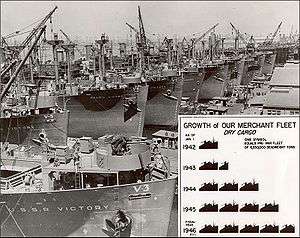 War Shipping Administration photo showing early 1944 Victory ship construction at California Shipbuilding Corporation with a May 1945 war tonnage production chart.
War Shipping Administration photo showing early 1944 Victory ship construction at California Shipbuilding Corporation with a May 1945 war tonnage production chart.- Eastine Cowner, a former waitress, at work on the Liberty ship SS George Washington Carver at the Kaiser shipyards, Richmond, California, in 1943.
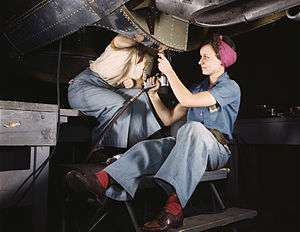 Women at work on bomber, Douglas Aircraft Company, Long Beach, California in October 1942
Women at work on bomber, Douglas Aircraft Company, Long Beach, California in October 1942 P-38 Lightning assembly line at the Lockheed plant, Burbank, California.
P-38 Lightning assembly line at the Lockheed plant, Burbank, California.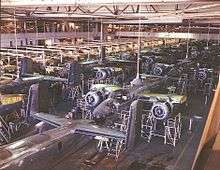 B-25 Mitchell bomber production line at the North American Aviation plant, Inglewood, California, October 1942.
B-25 Mitchell bomber production line at the North American Aviation plant, Inglewood, California, October 1942. US Ration Book No. 3 circa 1943, front
US Ration Book No. 3 circa 1943, front "How to Shop With Ration Book Two", 1943 poster
"How to Shop With Ration Book Two", 1943 poster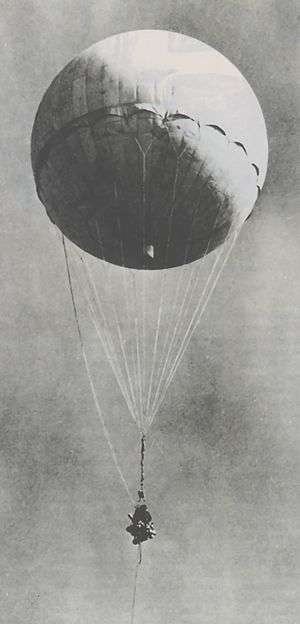 Shot-down Fu-Go balloon bomb reinflated by Americans in California
Shot-down Fu-Go balloon bomb reinflated by Americans in California Battle of Los Angeles, Photos from Los Angeles Times, 26 February 1942
Battle of Los Angeles, Photos from Los Angeles Times, 26 February 1942 American WWII-era poster promoting Victory gardens
American WWII-era poster promoting Victory gardens- GM California M5A1 tank on display
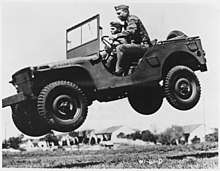 Army testing a California Ford GP (jeep) in 1941.
Army testing a California Ford GP (jeep) in 1941.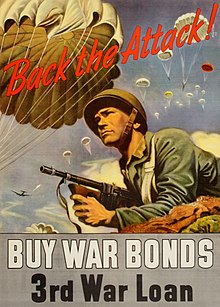 George Schreiber poster for the Third War Loan Drive (September 9 – October 1, 1943)
George Schreiber poster for the Third War Loan Drive (September 9 – October 1, 1943)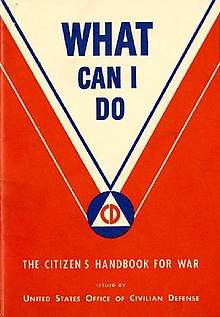 What Can I Do? The Citizen's Handbook for War, U.S. Office of Civilian Defense 1942
What Can I Do? The Citizen's Handbook for War, U.S. Office of Civilian Defense 1942
See also
References
- secondworldwarhistory.com World war 2 statistics
- history.army.mil, US Army, World War II, Korea And Vietnam Casualties
- capitolmuseum.ca.gov, California State Capitol Museum, California Transformed
- militarymuseum.org, California Military History, California and the Second World War
- csun.edu California for Educators, World War II and the late 20th Century
- militarymuseum.org, The Impact of the Second World War on Los Angeles
- capitolmuseum.ca.gov, After the War
- Effects of World War II on California Oil Reserves: by Graham B. Moody
- "Resident Population Data – 2010 Census". Census.gov. Retrieved October 7, 2017.
- travelmattersca.com History of tourism in California
- Houghton Mifflin Harcourt Company, California and World War II
- "World war II: Civic responsibility" (PDF). Smithsonian Institution. Retrieved 27 March 2014.
- "Sugar: U. S. consumers register for first ration books". Life. 1942-05-11. p. 19. Retrieved November 17, 2011.
- ""Creamless Days?" / The Pinch". Life. 1941-06-09. p. 38. Retrieved December 5, 2012.
- Joseph A. Lowande, U.S. Ration Currency & Tokens 1942–1945.
- "Zoot Suits Riots".
- Ng, Wendy L. (2002). Japanese American Internment During World War II: A History and Reference Guide. Greenwood Publishing Group. ISBN 978-0313313752.
- Cal, Parks Marker, 655, Temporary Detention Camp for Japanese Americans/Pomona Assembly Center
- Semiannual Report of the War Relocation Authority, for the period January 1 to June 30, 1946, not dated. Papers of Dillon S. Myer. Scanned image at trumanlibrary.org. Retrieved September 18, 2006.
- "The War Relocation Authority and The Incarceration of Japanese Americans During World War II: 1948 Chronology," Web page at www.trumanlibrary.org. Retrieved September 11, 2006.
- "Manzanar National Historic Site". National Park Service.
- Nash, Gary B., Julie Roy Jeffrey, John R. Howe, Peter J. Frederick, Allen F. Davis, Allan M. Winkler, Charlene Mires, and Carla Gardina Pestana. The American People, Concise Edition Creating a Nation and a Society, Combined Volume (6th Edition). New York: Longman, 2007
- Italian Prisoners of War and Italian Service Units: From Enemies to Co-belligerents, Paul J. Jordan, University of Massachusetts Boston
- militarymuseum.org, POW camps
- POW Camps in California
- militarymuseum.org Camp Haan
- militarymuseum.org, California POW camps
- history.com, 5 Attacks on U.S. Soil During World War II, by Evan Andrews, Aug 30, 2018
- The Shelling of Ellwood, The California State Military Museum, archived from the original on 5 January 2008, retrieved 2007-12-09
- Young, Donald J. Phantom Japanese Raid on Los Angeles Archived 2008-01-24 at the Wayback Machine World War II Magazine, September 2003
- militarymuseum.org, Battle of Los Angeles
- npr.org Beware Of Japanese Balloon Bombs, January 20, 2015, by Linton Weeks
- history.com, Attack of Japan's Killer WW II Balloons, 70 Years Ago, May 5, 2015
- Japan's World War II balloon bomb attacks on North America
- SS Samoa attacked
- militarymuseum.org SS Agwiworld
- militarymuseum.org The Attacks on the SS Barbara Olson and SS Absoroka
- SS Fort Camosun Sank
- SS Agwiworld attacked
- wrecksite.eu SS Camden
- Office of National Marine Sanctuaries, SS Camden
- 1942 Navy Department. Summary of Statements by Survivors SS Camden, United States Tanker, 6653 G.T., Charles Kurzand Company, Philadelphia, under Charter to Shell Oil Company
- SS H.M. Storey attacked
- SS H.M. Storey attacked
- SS Idaho tanker damaged
- SS Connecticut tanker damaged
- militarymuseum.org Victor Valley's Unsung Heros, by John Swisher
- Battle of Los Angeles
- USLO, The Armor of Democracy: Volunteerism on the Home Front in World War II California
- The Triumphant Partnership: California Cities and the Winning of World War II, California State University, Northridge, April 29, 2005
- Fourth Antiaircraft Command Brigadere, August 1945
- Panic on the Pacific: How America Prepared for the West Coast Invasion, By Bill Yenne
- kelpforestcalifornia.com Kelp Forest, California, By: Lauren R. and Melanie S.
- History of the Ammunition Industrial Base, Joint Munitions
- Center of Military History, Washington DC. Morris J. MacGregor, Jr. 1985. "World War II: The Navy. A Segregated Navy Archived June 8, 2010, at the Wayback Machine" in Integration of the Armed Forces 1940–1965. Retrieved March 5, 2009.
- Wagner et al., The Library of Congress World War II Companion, 295.
- Allen, The Port Chicago Mutiny, 35–36.
- americanhistory.si.edu, "Hollywood went to war in 1941 – and it wasn't easy", By Larry Margasak, May 3, 2016
- digitalhistory.uh.edu Wartime Hollywood
- militarymuseum.org Hollywood's Army, The First Motion Picture Unit, US Army Air Forces, Culver City, California by Master Sergeant George J. Siegel
- "Bob Hope: King of the Oscars". Biography. Archived from the original on July 28, 2017. Retrieved July 19, 2017.
- Quirk 1998, pp. 318–320.
- Grudens 2002, pp. 181–182.
- Who's Who In Hollywood! By Terry Rowan, Desi Arnaz, page 15
- capitolmuseum.ca War Bond
- Saving for Democracy, Online Oxford Scholarship, Thrift and Thriving in America: Capitalism and Moral Order from the Puritans to the Present, by Joshua Yates and James Davison HunterPrint, 2011
- militarymuseum.org, California National Guar
- nps.gov, Shipbuilding
- laconservancy.org, Shipbuilding
- shipbuildinghistory.com, Shipyards
- "shipbuildinghistory.com, Concrete Ships". Archived from the original on 2018-09-24. Retrieved 2019-10-04.
- shipbuildinghistory.com, wood ships
- nps.gov, Ship building
- hugheshistoricdistrict.com Aircraft industry Southern California
- Nicolaides, Becky M. (2002). My Blue Heaven. University of Chicago Press. ISBN 978-0-226-58301-3.
- Photos of South Gate Assembly plant.
- Rubenstein, James M (1992). The Changing US Auto Industry. London: Routledge. ISBN 978-0-203-03452-1.
- nps.gov Ford Motor Company Assembly Plant in Richmond, California,
- Willys-Overland West
- Chrysler’s Lost Los Angeles Plant, 1932–1971
- Studebaker Pacific Corporation
- militarybases.us Military installations California
- militarymuseum.org, Los Angeles Metropolitan Area during World War II
- militarymuseum.org, Army Bases map
- militarymuseum.org Desert Training Center
- U.S. Geological Survey Geographic Names Information System: Camp Granite (historical)
- militarymuseum.org California Naval Bases
- militarymuseum.org California World War II Army Airfields
- Air Force Base Sites History’s Legacy, by Frederick J.Shaw
- DIANE Publishing Company (1 October 1995). Defense Base Closure And Realignment Commission: Report To The President 1995. DIANE Publishing. p. 123. ISBN 978-0-7881-2461-7.
- "DDJC – Sharpe" (PDF). Superfund. Environmental Protection Agency. October 2003. Archived (PDF) from the original on 15 June 2015. Retrieved 13 June 2015.
- Dawn Bohulano Mabalon (29 May 2013). Little Manila Is in the Heart: The Making of the Filipina/o American Community in Stockton, California. Duke University Press. p. 233. ISBN 978-0-8223-9574-4.
- Carol A. Jensen (2006). Byron Hot Springs. Arcadia Publishing. p. 104. ISBN 978-0-7385-4700-8.
- "Historic Posts, Camps, Stations, and Airfields, Tracy Facility, Defense Distribution Depot San Joaquin". californiamilitaryhistory.org. The California State Military Museum. Archived from the original on 13 March 2018. Retrieved 11 September 2018.
